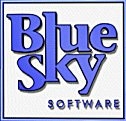Difference between revisions of "BlueSky Software"
From Sega Retro
| Line 7: | Line 7: | ||
| mergedwith= | | mergedwith= | ||
| mergedinto= | | mergedinto= | ||
| − | | headquarters=El Cajon, California | + | | headquarters=El Cajon, California, United States |
}} | }} | ||
Revision as of 14:52, 28 January 2020
BlueSky Software debuted in 1988 with a series of Atari 7800 Games. The company consisted of a handful of programmers and one artist when work on the games began. By the time they were finished, a second artist and a utility player had been added to the company roster. Concurrent with the 7800 games, a couple of Atari XE games were produced. After the 7800 and XE systems came games for the Atari Lynx, Amiga, Commodore 64 and the Sega Master System.
Games for the Sega Mega Drive account for a third of the BlueSky catalog, and span from 1991 to 1998—just over half of the time the company existed. BlueSky entered the Genesis market with Starflight and Joe Montana Football in 1991, as Sonic was arriving on the scene. (BlueSky would split its time between sports and non sports games until the last couple of years in was in business.) Soon after these games had been completed, BlueSky entered into an agreement to create games exclusively for Sega over the next few years.
With Sega's financial backing, BlueSky moved to larger offices, and staffed up for Jurassic Park, based on the hit movie. The game sold in huge numbers, and established BlueSky as a major player in the Genesis market. In 1994, having done football games for several years, BlueSky tried its hand at baseball with World Series Baseball. WSB featured a new 'in the batters box' view, along with an innovative control system for batting and pitching. WSB and its three sequels helped baseball games transition from generic fields and players, to MLB and MLBP licensed games reflecting the look of the individual fields, and with actual player names and stats.
Along with sports and movie themed games, BlueSky also did TV themed games such as The Ren & Stimpy Show Presents: Stimpy's Invention and Desert Demolition. In 1995, BlueSky introduced the world to its new in house creation, Vectorman. Vectorman's bright graphics and fluid animation pushed the Genesis to its limits, and garnered rave reviews.
By 1997, BlueSky was working on its last Genesis game, World Series Baseball 98, as it had exited its agreement with Sega, and was looking forward to new systems and new associations. The company took up most of its floor in the building, had produced a series of well received games culminating with Vectorman, and the future looked bright. However, there were dark clouds on the horizon. A bumpy transition to 32 bit, questionable management, and an exodus of employees to other companies all helped to start a downward spiral that would eventually lead to the end of BlueSky in 2001.
Contents
Softography
Master System
- Joe Montana Football (1990)
Mega Drive
- Starflight (1991)
- Joe Montana II Sports Talk Football (1991)
- NFL Sports Talk Football '93 Starring Joe Montana (1992)
- Ariel the Little Mermaid (1992)
- Jurassic Park (1993)
- TechnoClash (1993)
- NFL Football '94 Starring Joe Montana (1993)
- The Ren & Stimpy Show Presents Stimpy's Invention (1993)
- Jurassic Park: Rampage Edition (1994)
- Shadowrun (1994)
- World Series Baseball (1994)
- College Football's National Championship (1994)
- Vectorman (1995)
- Desert Demolition Starring Road Runner and Wile E. Coyote (1995)
- World Series Baseball '95 (1995)
- College Football's National Championship II (1995)
- Vectorman 2 (1996)
- World Series Baseball '96 (1996)
- World Series Baseball 98 (1997)
- Vectorman 3 (unreleased)
Game Gear
- Joe Montana Football (1991)
- Ariel the Little Mermaid (1992)
- NFL '95 (1994)
- Vectorman 3 (unreleased)
32X
Saturn
- Topps MVP Baseball '96 (unreleased)
- Vectorman 3 (unreleased)
Steam
- Vectorman 2 (2012)
